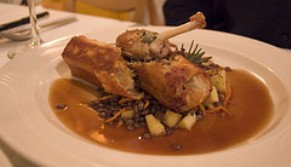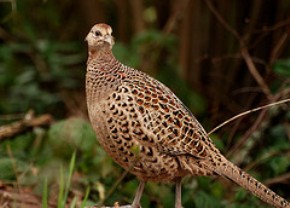Fall has arrived and so has the pheasant hunting season - depending on which State you are in that is and some may have to wait a couple of weeks longer to savor this delicious bird. As with eating any game birds just remember to look out for any errant gunshot pellets to save on costly dental work.
History
This often overlooked bird, with its gamy-poultry flavor, originated in Asia. Legend has it that they were carried into Europe by Jason and the Argonauts but it is probably more likely that they were carried in with the Romans. Although George Washington kept a few at Mount Vernon, The Common Pheasant or Ring Necked Pheasant wasn’t successfully introduced to the US until the late 1800’s where they thrived and by the 1920’s there were more than enough for establishment of shoots. Nowadays millions of them are artificially reared each year for hunting, 10 million in the US and 35 million in the UK.

Taste
Decidedly a free range bird, the pheasant’s diet of berries, seeds, shoots and insects, supplemented by pellets from the gamekeeper, contributes to their flavorful meat. The cock, with its brilliant colorful plumage, looks like it will be much tastier than the duller, mottled brown hen but that’s not the case. Although reared pheasant have a milder flavor than their wild counterparts they still have that distinctive gamy ring to them due to them being hung by their necks for up to ten days. The oils from their feathers and their innards remaining in place during this time augment the flavor, so if a strong taste is not to your palate, less is definitely more.
Pairing
The pheasant has a natural affinity to all manner of fruit and vegetables that flourish at this time of year. Juicy blackberries, cranberries, apples and pears. Fresh chestnuts and walnuts. All manner of squash and pumpkins. And of course, wild mushrooms.

Cooking
Telling the difference between an older and a younger bird while unplucked is possible by looking at the first wing tip feather. An older bird’s will be more rounded while a younger bird’s will be pointed. But when buying oven-ready, it will certainly pay to have a good relationship with an honest butcher. The pheasant has a naturally low fat content which may be a bonus for our waistlines but that’s not so good for in the oven. A young bird will need to be barded and stuffed to keep it moist while roasting whereas an older bird would be better slowly casseroled in a big red wine. Pheasant meat mixed with a few tasty ingredients like onions, garlic, bacon and herbs could be made into sausages or pies. Whizzed up to make a pate or soup. Or why not try an unusual recipe featuring green tea, walnuts and grape juice called
Georgian (or Circassian) Pheasant in the Gigachef Community Recipes database.
Photos courtesy of Ulterior Epicure and Portia and Paul - Flickr